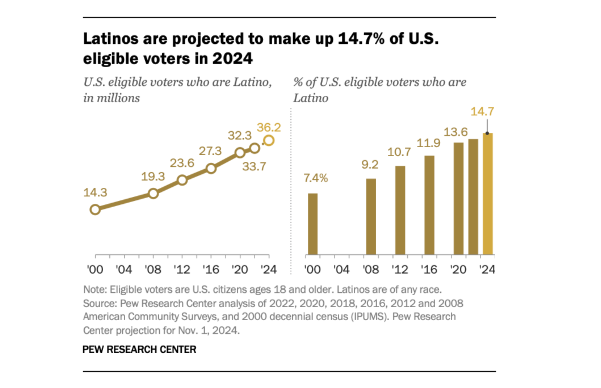
As the United States begins the lengthy process to determine who will be its next president, Latinos are set to play a more relevant role than in the past.
The demographic's proportion of the electorate continues to increase, and the trend is only expected to continue in this direction as it also shows the fastest population growth.
In this context, the Pew Research Center analyzed key stats regarding Latino eligible voters, highlighting they represented 50% of this category's growth between 2020 and 2024.
The proportion of the electorate, the states where there are more Latino eligible voters and the one in which they are the largest share of potential voters, as well as their average age, where other key facts listed. Here's a look at them.
The Pew Research Center showed how the share of Latino eligible voters has grown sustainedly over this century, going from 7.4% in 2000 to a projected 14.7% in the 2024 elections. When it comes to the amount of eligible voters, the figure went from 14.3 million 24 years ago to 36.2 million this year.

California is the state with the most eligible voters, being the home of some 8.5 million, a quarter of all Latinos in this category. "The next biggest states by number of Latino eligible voters are Texas (6.5 million), Florida (3.5 million), New York (2.2 million) and Arizona (1.3 million). Together, these five states hold about two-thirds (65%) of all Hispanic eligible voters," said Pew's article.
However, New Mexico is the state with the highest share of eligible voters in the country. Concretely, 45% of the total are Latinos, more than any other racial or ethnic group, including Whites and non-Hispanics, who represent 40% of the overall figure.
"In California and Texas, Hispanics are about a third of the eligible voter population (33% and 32%, respectively), while the ones with the next-largest "Latino shares of eligible voters are Arizona (25%), Nevada (22%), Florida (22%), Colorado (17%) and New Jersey (16%)," Pew added.
While the Latino population in the U.S. is growing rapidly, a large amount is not allowed to vote. The study shows that 53% were allowed to do so in 2022, a much smaller amount than Whites' 72%.
This is partly because the nation's Latino population includes a large number of people who are too young to vote or who are not U.S. citizens, Pew explained, saying that 29% of Latinos are under 18, compared to 22% of the U.S. overall, and that 19% are not U.S. citizens, compared to 6% of the total population.
"Latino immigrants who are not eligible to vote include permanent residents (green card holders) and those in the process of becoming permanent residents; those in the U.S. on temporary visas; and unauthorized immigrants," Pew added.
Finally, the study highlighted that Hispanic eligible voters tend to be younger than eligible voters overall, with only 33% of voters being 50 and older compared to 48% overall.
Latinos are set to be a key demographic both for Joe Biden. The latest poll focused on Latinos, conducted by USA TODAY/Suffolk University, showed Biden trailing Trump 39-34% with this demographic. The study highlights that in 2020 he had received 65% of the support, compared to Trump's 32%.
Another poll, from CNBC All-America, had Trump with a 5-point lead over current Biden in late December, becoming the first time the former President was ahead in such a poll over his likely competitor in next year's elections. The same poll from two months before had Biden with a 7-point lead.
© 2025 Latin Times. All rights reserved. Do not reproduce without permission.






